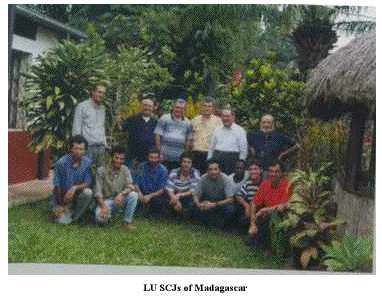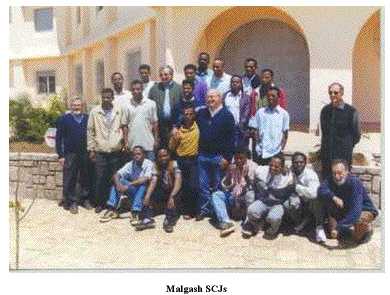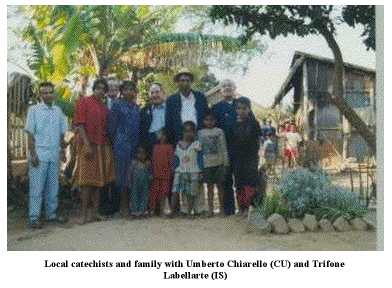MADAGASCAR: 25 YEARS OF SCJ PRESENCE
Fr. Umberto Chiarello, scj
Tananarive, 14 November, 1999
|
November 14 1974, was the day that the first SCJ missionary arrived
in Madagascar; he was Fr. Nicola Giampetro (IM).
November 14, 1999, was the date this anniversary was celebrated
by 47 SCJ religious, Portuguese, Italian, and Malagasy. As the Sunday liturgy
parable stated, the talents given by the Lord to the SCJs of Madagascar
increased and multiplied.
 After
a six month stay in Madagascar, Fr. Giampietro had to return to Italy on
June 5, 1975, due to illness. However, on October 4, 1975,
the first squad of Italians arrived; they included the newly ordained priests
Peppino Cuomo, Gaetano Di Piero, and Br. Filippo Buti. Charged by Bishop
Francesco Vollaro, ordinary of Ambatrondazaka, they began their missionary
work in the district of Imerimandroso, in the northern part of Madagascar,
near Lake Alaotra, and replaced the Trinitarians.
After
a six month stay in Madagascar, Fr. Giampietro had to return to Italy on
June 5, 1975, due to illness. However, on October 4, 1975,
the first squad of Italians arrived; they included the newly ordained priests
Peppino Cuomo, Gaetano Di Piero, and Br. Filippo Buti. Charged by Bishop
Francesco Vollaro, ordinary of Ambatrondazaka, they began their missionary
work in the district of Imerimandroso, in the northern part of Madagascar,
near Lake Alaotra, and replaced the Trinitarians.
Besides Italian SCJs, the Portuguese SCJs also came to Madagascar. The
pioneers were Fr. José Bairos Braga, Alfredo Caires, and Manuel
Jardim in January 1982. Given their charge by Bishop Xavier Tabao,
ordinary of Mananjary, they began their missionary work in the district
of Ifanandiana, in the southern part of Madagascar.
With each successive arrival of new missionaries, whether Italian or
Portuguese, the field of labor expanded. In the North, the Italians received
the district of Andreba in 1981 while in the South the Portuguese
obtained the district of Antsenavolo in February
1985 and Voilava
in May 1987. In June 1990, they left Voilava to take over
the district of South Ambohimanga. At Tananarive the capitol located in
the center of the country, the parish of Ambohimiray was given to them
in July 1991.
 These
were the stages of the historical growth of our missionary effort. To understand
the effort more deeply, the nature of the missionary district (location,
geographic size, number of villages and Christian communities, communications
setups and usability) needs clarification.
These
were the stages of the historical growth of our missionary effort. To understand
the effort more deeply, the nature of the missionary district (location,
geographic size, number of villages and Christian communities, communications
setups and usability) needs clarification.
The district of Imerimandroso is about 3,200 km -- (1,236 sq. miles)
containing 100 villages with 30 Christian communities; there are about
45,000 inhabitants of which 12,000 are Christian. Responsible for the area
are the two missionaries: Fr. Giuseppe Potenza and Giuseppe Nicolai.
The district of Andreba, is about 2,300 km -- (888 sq. miles) containing
about 50 villages with 20 Christian communities; there are 30,000 inhabitants
of which about 8,000 are Christian. Only one priest works there and he
is the vicar general of the diocese as well; he is assisted by two religious
brothers: Giuseppe Dubla and Filippo Buti.
The district of Ifanadiana is about 2500 km -- (965 sq. miles) with
about 71,800 inhabitants of which 15,760 are baptized Christians. Ifanadiana
is located at the center of the district with 125 churchs organized into
15 grooups. Two missionaries work there: Frs. Dinis Rodrigues and Alvao
Rodrigues; they are assisted by the scholastic, João Nélio
Simoes Pereira.
The district of Antsenavolo is about 2,000 km -- (772 sq. miles) and
contains over 100,000 inhabitants of which about 10% are Christian and
organized into 35 communities. Two tribes live there in addition to a racially
mixed group. Two missionaries work in the area: Fr. Leandro Gomes and Alcindo
De Sousa José and they are assisted by Fr. Daniel Yemtsa from the
Cameroun province.
The district of Ambohimanga South is about 1,500 km -- (579 sq. miles)
in size with 50,000 inhabitants of which 15-20% are Christian. Split in
two by the Mananjary river, the area requires a duplication of pastoral
effort on both sides of the river. There are no roads and the river has
no bridges. The district is made up of 102 Christian communities grouped
into 13 pastoral zones. Each pastoral zone has centers for 5-6 communities.
Two missionaries work in the area: Frs. Manuel Jardim and Armando Baptista
along with a scholastic Paulo Jorge Moreira.
 The
parish, Our Lady of Fatima, at Tananarive cares for over 70,000 souls of
which 10,000 are Christian. A single missionary works there, Fr. Nicola
Giampietro; he is assisted by a Malagasy scholastic, Justin.
The
parish, Our Lady of Fatima, at Tananarive cares for over 70,000 souls of
which 10,000 are Christian. A single missionary works there, Fr. Nicola
Giampietro; he is assisted by a Malagasy scholastic, Justin.
Each district has its churches and chapels built in brick and offering
a house for the missionary, a building for meetings and teaching catechists,
various activities and arrangements set up by the missionary. There is
also a house for the sisters who run the schools, dispensaries, and home
economics training programs.
The people in charge of the Christian communities are the laity themselves
who arrange things each in their own way and having different functions
and titles: catechists and trainees, committee president, inspector, treasurer,
etc…
Each Christian community has its own catechist who leads Sunday prayer,
prepares people for the sacraments. The missionary organizes his visits
so that he can celebrate mass at least once every two or three months in
the different centers or villages. He also checks preparations for the
sacraments and administers the sacraments. There are a number of catholic
associations from which vocations come, especially women. Formation of
catechists is the principal missionary activity. The catechists find their
way to the center of the district coming from far off villages and engage
for several days in the catechesis programs. The missionaries train these
people and help them acquire a biblical, pastoral, and catechetical knowledge
in preparation for the sacraments. The youth are organized as are those
preparing for marriage. It is the people themselves who arrange pilgrimages
to certain places of worship or for particular solemn occasions. The Malagasy
are a people on pilgrimage.
 From
the very beginning, the pastoral activity of the Italian SCJs was tied
to human development by the collaboration of the ONG organization, Laity
for the Third World (LTM), in the area of carpentry and farming. Another
useful arrangement shown by the Portuguese SCJs is the sending of scholastics
for a two year presence in the missionary districts.
From
the very beginning, the pastoral activity of the Italian SCJs was tied
to human development by the collaboration of the ONG organization, Laity
for the Third World (LTM), in the area of carpentry and farming. Another
useful arrangement shown by the Portuguese SCJs is the sending of scholastics
for a two year presence in the missionary districts.
A basic component of missionary activity has been involvement in vocations
work. At the beginning of 1983, with the encouragement of IM provincial,
Andreba saw the establishment of a "foyer" for SCJ vocations. In July,
1987, the first candidates for the novitiate left for the Cameroun.
In 1989, the house at Tananarive received its first Malagasy religious.
In February 1996, the first candidates for aspirancy entered at
Fiananrantsoa. And in 1997, a novitiate at Antsirabe accepted both
novices and postulants. Presently, Madagascar has all the components necessary
for the formation of SCJ vocations.
The aspirancy at Fianarantsoa, "House of our Lady of Fatima", has 24
aspirants; 5 are just beginning, 4 are in the next year, 7 in the first
year, and 8 are completing their studies. Frs. Pedro Fernandes, Clemente
Gonçalves, and Br. José Manuel Ferreira are in charge.
The novitiate at Antsirabe, "Maison P. Dehon" has 6 postulants and 4
novices. Fr. Alfredo Caires is the superior and Fr. Giuseppe Cuomo is the
novice master.
At the scholasticate (philosophy and theology) in Tananarive, "Maison
S. Coeur" there are 14 scholastics: 3 in first year of philosophy, 3 in
second year and 5 in the third. Additionally, there are 3 in first theology
and 1 in third year theology. Frs. Rocco Nigro and Luis Ernesto Miranda
are in charge. Four other Malagasy scholastics are doing their "regency":
1 at Antsirabe, 1 in the parish of Tananarive, and 2 at Fianarantsoa.
Additionally, there are three lay brothers: 1 at Antsirabe, 1 at the
scholasticate at Tananarive, and 1 at Fianarantsoa.
 Lastly,
there are two Cameroon religious present in Madagascar, one lay brother
at Antsenavolo sent as a missionary from his province and 1 scholastic
at Tananarive in first year theology.
Lastly,
there are two Cameroon religious present in Madagascar, one lay brother
at Antsenavolo sent as a missionary from his province and 1 scholastic
at Tananarive in first year theology.
The superior of the SCJ Malagasy community is Fr. Pasquale Marinucci
while the treasurer is Fr. Stefano Sardini, both resident at Tananarive.
Taken all together, there are 47 SCJ religious: 10 Italians, 14 Portuguese,
21 Malagasy, and 2 Camerounais.
In addition to these living, one needs to add three deceased religious:
Fr. José de Bairos Braga, first Portuguese missionary, who died
in East Providence (USA) on November 1, 1998; the scholastic Philippe
Rakotomarolahy, who died at Tananarive on January 2, 1999. One can
also add Fr. Michele Bulmetti, an Italian missionary, who went first to
Mozambique, then Madagascar, and who died in Albania on May 4, 1999.
These three constitute the first Malagasy community in heaven.
The celebration of the twenty-fifty began with a week long spiritual
retreat given by Fr. Umberto Chiarello to all the missionaries assembled
at Antisrabe, based on the SCJ spirituality and mission found in the Rule
of Life. An assembly then took place which included the Malagasy religious;
the scope was to become informed about the new Structures of the Congregation
and the plan We, the Congregation: in Service to the Mission. All
three groups (Malagasy, Portuguese, and Italian) unanimously decided to
request the General Administration to establish a Region
nullius provinciae
of the Malagasy community. On November 14, 1999, at the parish of Tananarive
where Fr. Nicola Giampietro is pastor, a solemn thanksgiving mass was celebrated
under the presidency of Fr. Pasquale Marinucci, superior of the Malagasy
community. Also present were: Fr. Umberto Chiarello, assistant general,
and the provincials of the LU and IM provinces: Neto Quintas and Trifone
Labellarte. Many missionaries were present as well as the entire group
of Malagasy scholastics.
The 25 years that the SCJ have been present in Madagascar appear to
be rewarded with a very interesting development. A rich woman, Madame Denise
Crees, wishes to establish a private university at Antsirabe. Construction
has begun on the building complex and a professor from Tananarive is organizing
a group of teachers from the University of Tanarive who are willing to
teach at Antsirabe. Four faculties are envisaged at the outset: Farming
Sciences, Computer Technology, Communications, and Economics. Startup is
foreseen for September, 2000. Madame Denis, who is a friend to our priests
at Antsirabe, has already donated the land and the building to the Malagasy
SCJs and has in mind to give the property and administration of the private
university to them as well. Her intention is to promote culture at a university
level in these professional fields. This would be a truly work worthy of
SCJ presence in Madagascar. Madagascar: a mission of two mother provinces:
South Italy and Portugal.

Pasquale Marinucci (IM)
area superior
 After
a six month stay in Madagascar, Fr. Giampietro had to return to Italy on
June 5, 1975, due to illness. However, on October 4, 1975,
the first squad of Italians arrived; they included the newly ordained priests
Peppino Cuomo, Gaetano Di Piero, and Br. Filippo Buti. Charged by Bishop
Francesco Vollaro, ordinary of Ambatrondazaka, they began their missionary
work in the district of Imerimandroso, in the northern part of Madagascar,
near Lake Alaotra, and replaced the Trinitarians.
After
a six month stay in Madagascar, Fr. Giampietro had to return to Italy on
June 5, 1975, due to illness. However, on October 4, 1975,
the first squad of Italians arrived; they included the newly ordained priests
Peppino Cuomo, Gaetano Di Piero, and Br. Filippo Buti. Charged by Bishop
Francesco Vollaro, ordinary of Ambatrondazaka, they began their missionary
work in the district of Imerimandroso, in the northern part of Madagascar,
near Lake Alaotra, and replaced the Trinitarians.
 These
were the stages of the historical growth of our missionary effort. To understand
the effort more deeply, the nature of the missionary district (location,
geographic size, number of villages and Christian communities, communications
setups and usability) needs clarification.
These
were the stages of the historical growth of our missionary effort. To understand
the effort more deeply, the nature of the missionary district (location,
geographic size, number of villages and Christian communities, communications
setups and usability) needs clarification.
 The
parish, Our Lady of Fatima, at Tananarive cares for over 70,000 souls of
which 10,000 are Christian. A single missionary works there, Fr. Nicola
Giampietro; he is assisted by a Malagasy scholastic, Justin.
The
parish, Our Lady of Fatima, at Tananarive cares for over 70,000 souls of
which 10,000 are Christian. A single missionary works there, Fr. Nicola
Giampietro; he is assisted by a Malagasy scholastic, Justin.
 From
the very beginning, the pastoral activity of the Italian SCJs was tied
to human development by the collaboration of the ONG organization, Laity
for the Third World (LTM), in the area of carpentry and farming. Another
useful arrangement shown by the Portuguese SCJs is the sending of scholastics
for a two year presence in the missionary districts.
From
the very beginning, the pastoral activity of the Italian SCJs was tied
to human development by the collaboration of the ONG organization, Laity
for the Third World (LTM), in the area of carpentry and farming. Another
useful arrangement shown by the Portuguese SCJs is the sending of scholastics
for a two year presence in the missionary districts.
 Lastly,
there are two Cameroon religious present in Madagascar, one lay brother
at Antsenavolo sent as a missionary from his province and 1 scholastic
at Tananarive in first year theology.
Lastly,
there are two Cameroon religious present in Madagascar, one lay brother
at Antsenavolo sent as a missionary from his province and 1 scholastic
at Tananarive in first year theology.
